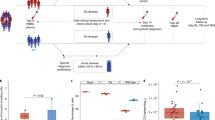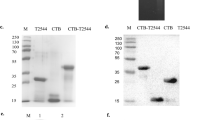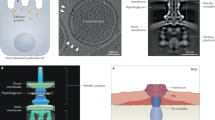Abstract
Typhoid fever is a life-threatening disease, but little is known about the molecular bases for its unique clinical presentation. Typhoid toxin, a unique virulence factor of Salmonella Typhi (the cause of typhoid fever), recapitulates in an animal model many symptoms of typhoid fever. Typhoid toxin binding to its glycan receptor Neu5Ac is central, but, due to the ubiquity of Neu5Ac, how typhoid toxin causes specific symptoms remains elusive. Here we show that typhoid toxin displays in vivo tropism to cells expressing multiantennal glycoprotein receptors, particularly on endothelial cells of arterioles in the brain and immune cells, which is in line with typhoid symptoms. Neu5Ac displayed by multiantennal N-glycans, rather than a single Neu5Ac, appears to serve as the high-affinity receptor, as typhoid toxin possesses five identical binding pockets per toxin. Human counterparts also express the multiantennal Neu5Ac receptor. Here we also show that mice immunized with inactive typhoid toxins and challenged with wild-type typhoid toxin presented neither the characteristic in vivo tropism nor symptoms. These mice were protected against a lethal-dose toxin challenge, but Ty21a-vaccinated mice were not. Cumulatively, these results reveal remarkable features describing how a bacterial exotoxin induces virulence exclusively in specific cells at the organismal level.
This is a preview of subscription content, access via your institution
Access options
Access Nature and 54 other Nature Portfolio journals
Get Nature+, our best-value online-access subscription
$29.99 / 30 days
cancel any time
Subscribe to this journal
Receive 12 digital issues and online access to articles
$119.00 per year
only $9.92 per issue
Buy this article
- Purchase on Springer Link
- Instant access to full article PDF
Prices may be subject to local taxes which are calculated during checkout




Similar content being viewed by others
Change history
13 June 2019
An amendment to this paper has been published and can be accessed via a link at the top of the paper.
References
Dougan, G. & Baker, S. Salmonella enterica serovar Typhi and the pathogenesis of typhoid fever. Annu. Rev. Microbiol. 68, 317–336 (2014).
Wain, J., Hendriksen, R. S., Mikoleit, M. L., Keddy, K. H. & Ochiai, R. L. Typhoid fever. Lancet 385, 1136–1145 (2015).
Crump, J. A. & Mintz, E. D. Global trends in typhoid and paratyphoid fever. Clin. Infect. Dis. 50, 241–246 (2010).
Crump, J. A., Sjolund-Karlsson, M., Gordon, M. A. & Parry, C. M. Epidemiology, clinical presentation, laboratory diagnosis, antimicrobial resistance, and antimicrobial management of invasive salmonella infections. Clin. Microbiol. Rev. 28, 901–937 (2015).
Ali, G., Rashid, S., Kamli, M. A., Shah, P. A. & Allaqaband, G. Q. Spectrum of neuropsychiatric complications in 791 cases of typhoid fever. Trop. Med. Int. Health 2, 314–318 (1997).
Lutterloh, E. et al. Multidrug-resistant typhoid fever with neurologic findings on the Malawi–Mozambique border. Clin. Infect. Dis. 54, 1100–1106 (2012).
Sejvar, J. et al. Neurologic manifestations associated with an outbreak of typhoid fever, Malawi–Mozambique, 2009: an epidemiologic investigation. PLoS ONE 7, e46099 (2012).
Szabo, I. et al. Neurologic complications and sequellae of infectious diseases in Uganda and Kenya: analysis of 288 cases from two rural hospitals. Neuro. Endocrinol. Lett. 34, 28–31 (2013).
Song, J., Gao, X. & Galan, J. E. Structure and function of the Salmonella Typhi chimaeric A2B5 typhoid toxin. Nature 499, 350–354 (2013).
Hornick, R. B. et al. Typhoid fever: pathogenesis and immunologic control. New Engl. J. Med. 283, 686–691 (1970).
Fraser, A., Paul, M., Goldberg, E., Acosta, C. J. & Leibovici, L. Typhoid fever vaccines: systematic review and meta-analysis of randomised controlled trials. Vaccine 25, 7848–7857 (2007).
Liang, L. et al. Immune profiling with a Salmonella Typhi antigen microarray identifies new diagnostic biomarkers of human typhoid. Sci. Rep. 3, 1043 (2013).
Charles, R. C. et al. Characterization of anti-Salmonella enterica serotype Typhi antibody responses in bacteremic Bangladeshi patients by an immunoaffinity proteomics-based technology. Clin. Vaccine Immunol. 17, 1188–1195 (2010).
Tran Vu Thieu, N. et al. An evaluation of purified Salmonella Typhi protein antigens for the serological diagnosis of acute typhoid fever. J. Infect. 75, 104–114 (2017).
Deng, L. et al. Host adaptation of a bacterial toxin from the human pathogen Salmonella Typhi. Cell 159, 1290–1299 (2014).
Chou, H. H. et al. Inactivation of CMP-N-acetylneuraminic acid hydroxylase occurred prior to brain expansion during human evolution. Proc. Natl Acad. Sci. USA 99, 11736–11741 (2002).
Song, J. et al. A mouse model for the human pathogen Salmonella Typhi. Cell Host Microbe 8, 369–376 (2010).
Chong, A., Lee, S., Yang, Y. A. & Song, J. The role of typhoid toxin in Salmonella Typhi virulence. Yale J. Biol. Med. 90, 283–290 (2017).
Haghjoo, E. & Galan, J. E. Salmonella Typhi encodes a functional cytolethal distending toxin that is delivered into host cells by a bacterial-internalization pathway. Proc. Natl Acad. Sci. USA 101, 4614–4619 (2004).
Spano, S., Ugalde, J. E. & Galan, J. E. Delivery of a Salmonella Typhi exotoxin from a host intracellular compartment. Cell Host Microbe 3, 30–38 (2008).
Chang, S. J., Song, J. & Galan, J. E. Receptor-mediated sorting of typhoid toxin during its export from Salmonella Typhi-infected cells. Cell Host Microbe 20, 682–689 (2016).
Hatcher, J. P. et al. Development of SHIRPA to characterise the phenotype of gene-targeted mice. Behav. Brain Res. 125, 43–47 (2001).
Rogers, D. C. et al. SHIRPA, a protocol for behavioral assessment: validation for longitudinal study of neurological dysfunction in mice. Neurosci. Lett. 306, 89–92 (2001).
Rutenber, E., Ready, M. & Robertus, J. D. Structure and evolution of ricin B chain. Nature 326, 624–626 (1987).
Geisler, C. & Jarvis, D. L. Effective glycoanalysis with Maackia amurensis lectins requires a clear understanding of their binding specificities. Glycobiology 21, 988–993 (2011).
Peng, W. et al. Recent H3N2 viruses have evolved specificity for extended, branched human-type receptors, conferring potential for increased avidity. Cell Host Microbe 21, 23–34 (2017).
Cryz, S. J. Jr et al. Construction and characterization of a Vi-positive variant of the Salmonella Typhi live oral vaccine strain Ty21a. Infect. Immun. 57, 3863–3868 (1989).
Galan, J. E. & Curtiss, R. III Distribution of the invA, -B, -C, and -D genes of Salmonella typhimurium among other Salmonella serovars: invA mutants of Salmonella Typhi are deficient for entry into mammalian cells. Infect. Immun. 59, 2901–2908 (1991).
Biasini, M. et al. SWISS-MODEL: modelling protein tertiary and quaternary structure using evolutionary information. Nucleic Acids Res. 42, W252–W258 (2014).
Jo, S., Song, K. C., Desaire, H., MacKerell, A. D. Jr & Im, W. Glycan Reader: automated sugar identification and simulation preparation for carbohydrates and glycoproteins. J. Comput. Chem. 32, 3135–3141 (2011).
Acknowledgements
The authors thank J. E. Galán for his suggestion on the typhoid toxoid vaccination study, which was initiated while J.S. was at Yale, N. Nishimura for her comments on brain images, and X. Gao for plasmid pET21a-pltB-His6. This work was supported by a Cornell University Startup, PCCW Affinito-Stewart Award and the USDA/NIFA Hatch project 1010701 (to J.S.), the NIH, NCI, under contract no. HHSN261200800001E (to R.N.), the NIH, NIDCD intramural research programme (to J.Z.), and NIH R01 AI114730 to J.C.P. The funders had no role in the study design, data collection and analysis, decision to publish, or preparation of the manuscript.
Author information
Authors and Affiliations
Contributions
Y.-A.Y. conducted the experiments shown in Figs. 1, 2, 3a and 4d,g–k, Supplementary Figs. 1–6 and 9–11 and Supplementary Videos 1–10. S.L. conducted the experiments in Figs. 4a–c,e,f. J.Z. conducted the analyses and simulations in Figs. 3b–e. R.N. supervised the computational project. L.D. contributed to Fig. 3. A.J.T. conducted the experiments in Supplementary Fig. 8. R.M. conducted experiments in Fig. 3f and Supplementary Fig. 7. B.T. contributed to Supplementary Figs. 7 and 8. J.C.P. supervised the glycan microarray project. J.S. was involved in the design, interpretation and supervision of this study. Y.-A.Y. and J.S. wrote the paper and all the authors commented on the manuscript.
Corresponding author
Ethics declarations
Competing interests
The authors declare no competing financial interests.
Additional information
Publisher’s note: Springer Nature remains neutral with regard to jurisdictional claims in published maps and institutional affiliations.
Electronic supplementary material
Supplementary Information
Supplementary Figures 1–11, Supplementary Tables 1-4, Supplementary Methods, Supplementary References, Supplementary Data
Supplementary Table 5
Related to Fig. 3f and Supplementary Fig. 7. Lists of glycans and glycan microarray results. Data for individual glycans are reported as relative fluorescence intensities from four of six replicates (after removal of highest and lowest values)
Supplementary Video 1
Related to Fig. 1c. A representative video showing ataxia signs typically seen 4.5–5 days after WT toxin administration
Supplementary Video 2
Related to Fig. 1c. A representative video showing clonic seizure signs typically seen 5–6 days after WT toxin administration
Supplementary Video 3
Related to Fig. 1d. A representative balance beam test of C57BL/6 mice administered PBS. Balance beam tests were conducted 5 days after PBS buffer administration
Supplementary Video 4
Related to Fig. 1d. A representative result of balance beam tests of mice administered WT toxin. Balance beam tests were conducted 5 days after WT toxin administration
Supplementary Video 5
Related to Fig. 1d. Another representative result of balance beam tests of mice administered WT toxin. Balance beam tests were conducted 5 days after WT toxin administration
Supplementary Video 6
Related to Fig. 1d. A representative result of balance beam tests of mice administered a PltB catalytic mutant toxin. Balance beam tests were conducted 5 days after indicated toxin administration
Supplementary Video 7
Related to Fig. 1f. A representative result of balance beam tests of mice administered a PltA catalytic mutant toxin. Balance beam tests were conducted 5 days after indicated toxin administration
Supplementary Video 8
Related to Fig. 1f. A representative result of balance beam tests of mice administered a CdtB catalytic mutant toxin. Balance beam tests were conducted 5 days after indicated toxin administration
Supplementary Video 9
Related to Supplementary Fig. 2. A representative result of balance beam tests of mice infected with a lethal dose of S. Typhimurium. A group of C57BL/6 mice were infected orally with 107 S. Typhimurium SL1344. The balance beam test was conducted 5 days after infection
Supplementary Video 10
Related to Fig. 4i. A representative result of balance beam tests of mice immunized by typhoid toxoid and challenged by a lethal dose of typhoid toxin. A group of C57BL/6 mice were immunized by subcutaneous injections of typhoid toxoid via a standard prime-boost regimen. Two weeks after boost, the immunized mice were challenged with 2 μg WT typhoid toxin. Balance beam tests were conducted 5 days after the WT toxin challenge
Rights and permissions
About this article
Cite this article
Yang, YA., Lee, S., Zhao, J. et al. In vivo tropism of Salmonella Typhi toxin to cells expressing a multiantennal glycan receptor. Nat Microbiol 3, 155–163 (2018). https://doi.org/10.1038/s41564-017-0076-4
Received:
Accepted:
Published:
Issue Date:
DOI: https://doi.org/10.1038/s41564-017-0076-4
This article is cited by
-
Glycan-dependent cell adhesion mechanism of Tc toxins
Nature Communications (2020)
-
Investigation of the role of typhoid toxin in acute typhoid fever in a human challenge model
Nature Medicine (2019)
-
Decoding glycan recognition by bacterial toxins
Nature Microbiology (2018)
-
Humanized model mice by genome editing and engraftment technologies
Molecular & Cellular Toxicology (2018)



